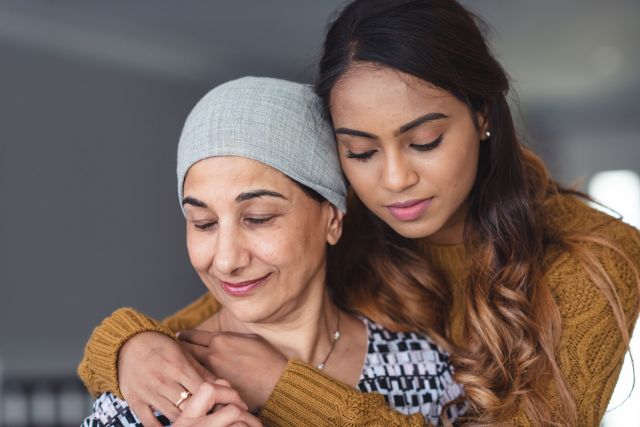Updated on September 13, 2023.
When it comes to breast and ovarian cancers, family history can be revealing. Cancer experts have known for years that having a close blood relative (such as a parent or sibling) with certain cancer types can raise your risk for the same type of cancer. But the risk may reach even further, making you more likely to develop a cancer that doesn't seem related to the one your family member might have.
The family-cancer connection
A 2018 study published in PLOS One looked at the risk of being diagnosed with ovarian cancer based on family history. The risk more than doubled if a person’s mother or sisters had ovarian cancer, compared to someone without a family history of the disease. If both mother and sister had ovarian cancer, the risk was roughly 10 times higher, and higher still if the family member was diagnosed before the age of 50.
Notably, a family history of other forms of cancer—particularly breast cancer and colorectal cancer—can also increase your risk for ovarian cancer.
One reason for these family connections is that certain genes influence multiple types of cancer. That means if multiple family members share a genetic variation, it could boost the risk of more than one type of cancer. For ovarian cancer in particular, it’s believed that as many as 25 percent of cases may be attributable to genetics.
For example, mutations in the BRCA1 and BRCA2 genes—which encode proteins that help repair DNA—raise the risk for breast cancer and are responsible for most cases of inherited ovarian cancers. If someone has a mutation in the BRCA1 gene, their lifetime risk of having ovarian cancer may be anywhere from 35 to 70 percent. (In other words, for every 100 people who have BRCA1 mutation, as many of 70 of them may be diagnosed with ovarian cancer.) For the BRCA2 mutation, that risk is believed to be between 10 to 30 percent by age 70. Mutations in several other genes—including PALB2, TP53, CHEK2, RAD51, and BRIP1—are also linked to a higher risk of ovarian cancer.
Statistics like these may sound troubling. But they point to the importance of understanding family history and sharing that information with your healthcare provider (HCP).
How to take action
If you have a family history of cancer, you may want to look into matters a little more deeply. Need some help getting started? In addition to mapping out your family health history, here's what you can do.
Make prevention a priority
According to the Centers for Disease Control and Prevention (CDC), smoking doesn’t only pose a risk to your lungs. It can cause cancer almost anywhere in your body. So if you smoke, quit. That’s one of the most powerful things you can do to prevent cancer.
Other risk factors for ovarian cancer can be hard to pin down and may be difficult for all people to address. For example, research shows that using birth control pills lowers the risk of ovarian cancer for people at average risk of the disease and for those who have BRCA mutations. But taking the pill comes with its own set of risks, so it’s important to consult with an HCP if you choose to take it.
People who have had certain medically prescribed gynecologic surgeries may also have a reduced risk of ovarian cancer. These include tubal ligation (during which the fallopian tubes are cut or blocked to prevent pregnancy) and hysterectomy (which involves the surgical removal of the uterus.)
Childbirth and breastfeeding may also decrease the risk of ovarian cancer, but experts would not recommend having a child for the purpose of ovarian cancer prevention.
Consider getting tested
The National Comprehensive Cancer Network recommends genetic testing for anyone diagnosed with ovarian cancer, regardless of family history. This testing can determine if a genetic mutation contributed to the cancer. If a genetic variation is detected, other family members should be informed so that they can discuss testing with their HCPs.
Likewise, you may want to consider genetic testing if your family history suggests that a close relative has a high risk of inherited ovarian cancer. A genetic counselor or other HCP with experience in genetic risk assessment can guide you.
People who test positive for genetic mutations and are thus at high risk for ovarian cancer may consider having their ovaries and fallopian tubes surgically removed to reduce the risk of cancer. It’s worth noting, however, that one’s risk of ovarian cancer is not completely eliminated by having the procedure, and it comes with its own complications, including premature menopause and the inability to become pregnant naturally.
Maintain a personal health record
As you learn more about how cancer has affected your family, make notes so that your personal health record is always up to date. Your personal health record should include a complete family history of cancer. The family history should include blood relative including your parents, grandparents, aunts, uncles, siblings, children, nieces, and nephews. Information about your family members should include the type(s) of cancer they have or had, the age at which they were diagnosed, and the age they passed away.
Key takeaways
Knowing your family history is a powerful tool in understanding your cancer risk. While it may be uncomfortable to face, this knowledge can also help you get diagnosed earlier, when the treatment options are more varied and the survival prospects more optimistic.






